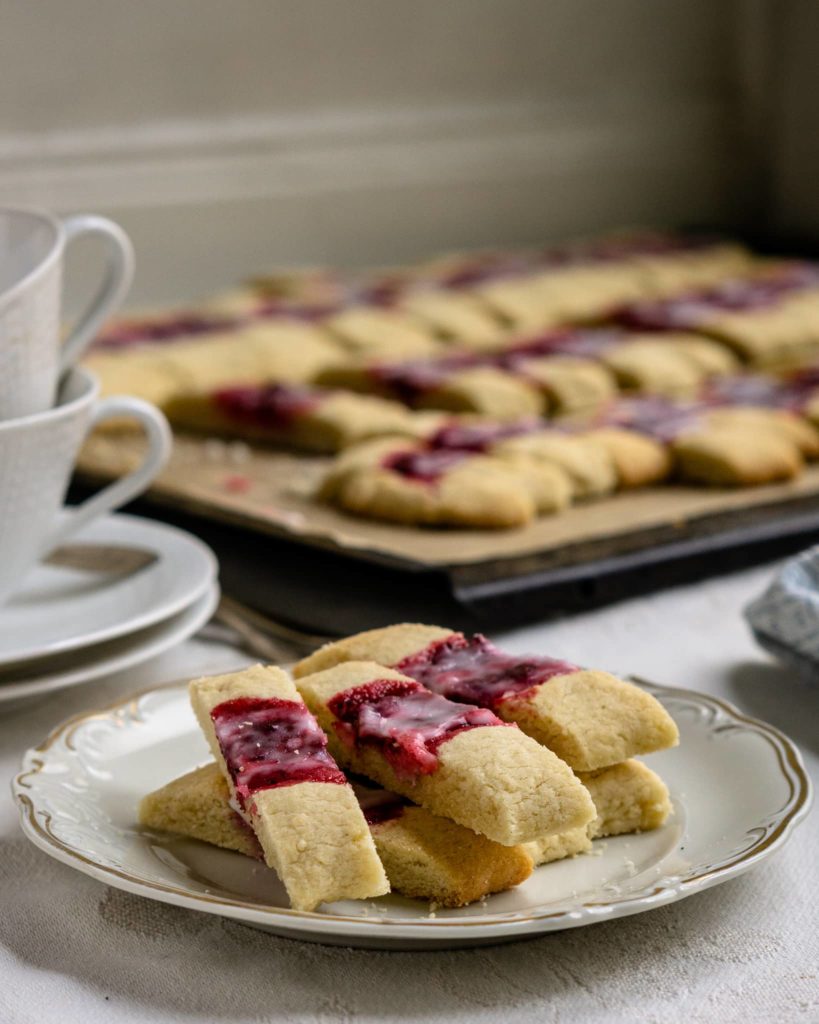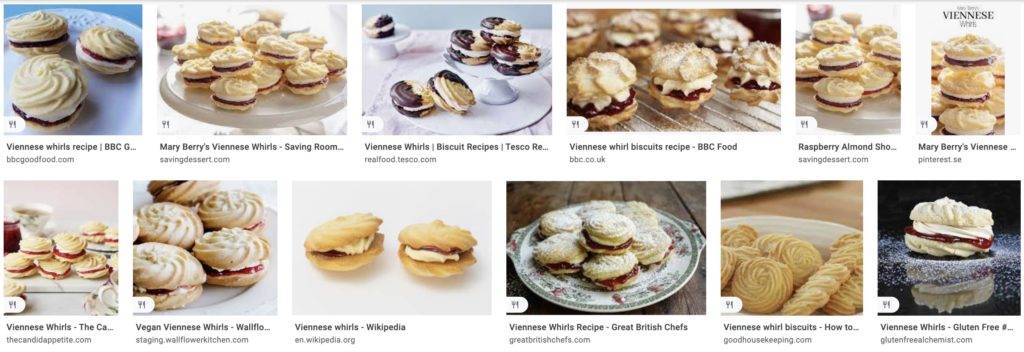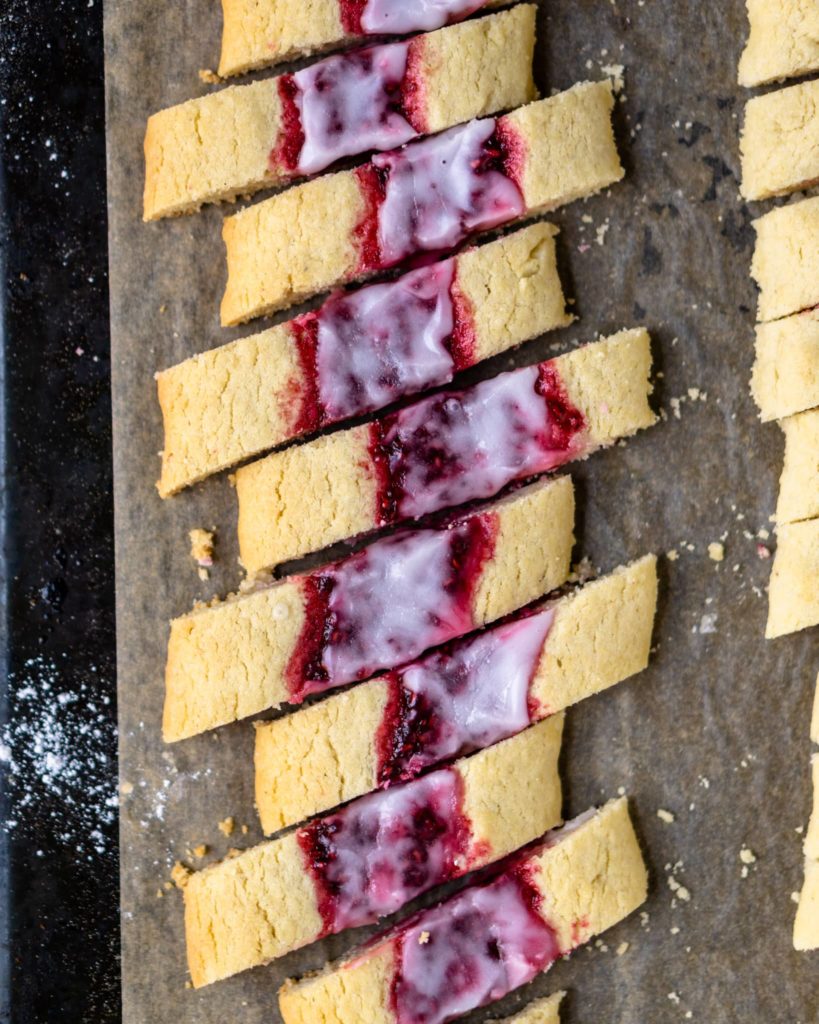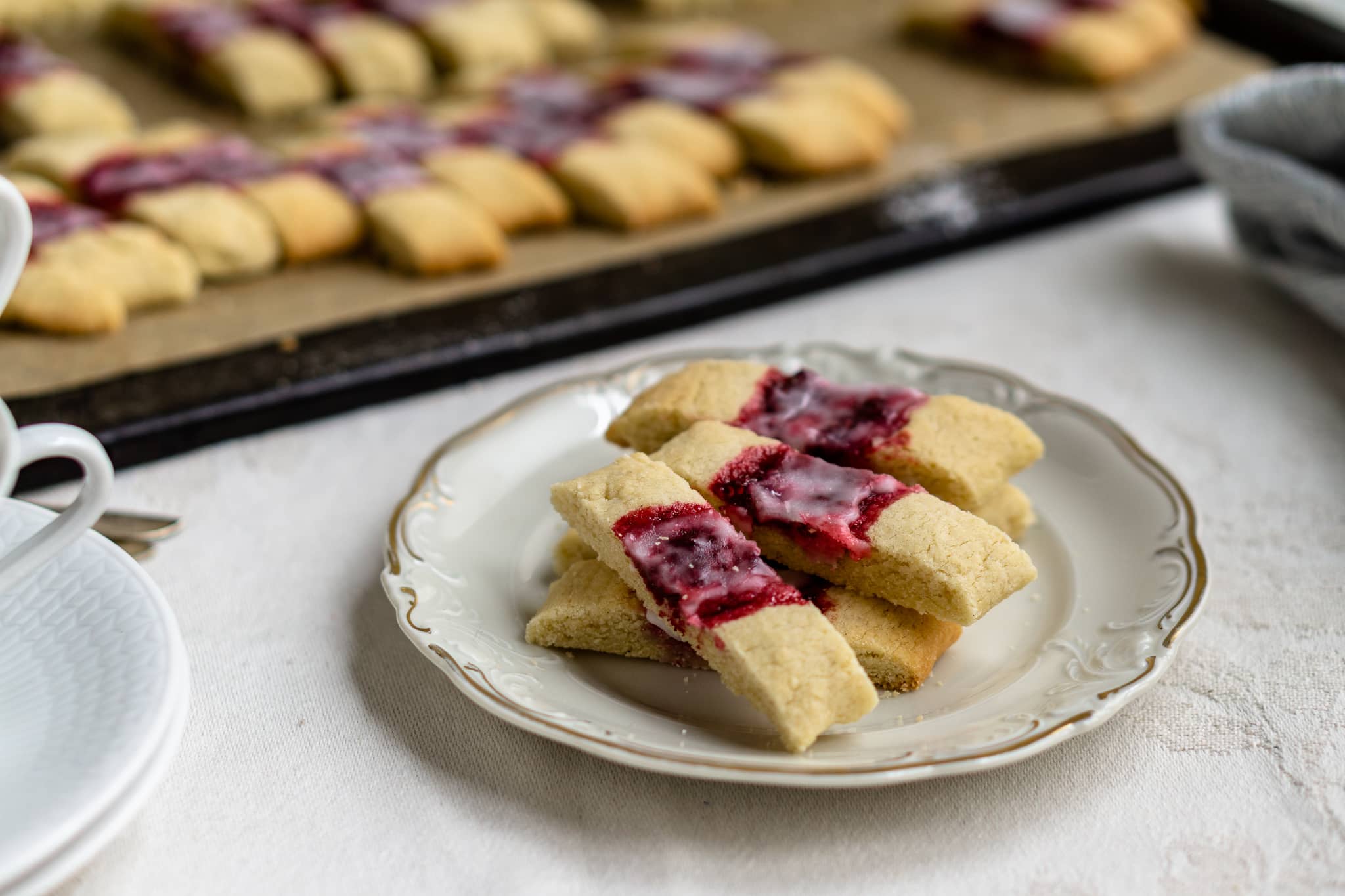These cookies have a wealth of names both in Swedish and in English. In Sweden, they are known as wienerstänger, syltsnittar, hallonsnittar, or skurna syltkakor. Some of the names I’ve encountered in English include Scandinavian raspberry ribbons, Swedish raspberry ribbon cookies, raspberry diamonds, jelly slices, jam diagonals, and split second cookies.
Regardless of what you choose to call them… they don’t sound that special, right?
Shortbread. Jam. Glazing. Done.
But the combination of the jam and the glazing is exquisite and it helps these cookies stay delicious for a long time. Not that you’ll have an easy time testing that — a full batch has yet to survive more than 24 hours at the small office where I sit.

Why are Swedish raspberry ribbons referred to as Viennese?
I usually try to find out a bit about the origins of the food I share on this site. So, why are these cookies known as Viennese in Swedish — wienerstänger?
The short answer: I don’t know yet. So, I will have to indulge in wild yet somewhat credible speculations.
A search shows that other countries have cookies with raspberry jam that get connected to Vienna. For example, in England, we have viennese whirls, often consisting of spritzed cookies filled with raspberry jam and a buttercream filling.

Could it be as simple as the Viennese connection simply being from stealing the colors of the Austrian flag?
Another suggestion is that the filling is similar to that of Danish pastry (often filled with custard or jam and a glaze), which are known as Viennese pastry in Sweden — wienerbröd.
Oh well, this is still nothing but speculation, and you’ll have to excuse my deficient findings, but they were not due to lack of effort.
Raspberry ribbons during the 20th century
Anyway. Some versions of raspberry ribbons seem to have become popular during the 20th century. In Mellerstedt’s Svensk konditorbok from 1924, we find a recipe for German jam breads. Apart from flour, egg, milk, hartshorn salt, lemon peel, and sugar, it contains cookie crumbs, almonds, and ground bitter almond peel — plus something referred to as “cake spice”. This dough is made into “hand-wide logs” that are filled with raspberry marmalade in the middle and glazed with a lemon glaze after baking. Well, even if the dough is very different, we can still see some similarities to wienerstänger.
The most similar recipe from Prinsessornas kokbok (1934) is “jam cookies with almond paste”. It is a round cookie with a spritzed ring of almond paste on top. The ring is filled with jam and glazed after baking. These raspberry ribbons are far easier!
A recipe for jam cookies in Svenska Dagbladet from Christmas-time in 1947 suggests that you make an “elongated, large cookie”, spread it with jam in the middle, and folds the sides towards the middle. This recipe uses a classic 1-2-3 dough — with the addition of an egg — and the cookies get no glazing.
The cookies wienerstänger won first prize in a big baking competition by ICA-Kuriren in 1945. The competition resulted in the popular baking book Sju sorters kakor, first published the same year. So, these cookies want first prize — out of 8,000 entries! According to Svenska Dagbladet, the recipe creator Margaretha Johannesson bought a swagger coat for the prize sum of 50 SEK.
More recently, the cookies appear in as winerstänger in Svenska Dagbladet for the first time in November in 1994.

How to make Swedish raspberry ribbons
Baking raspberry ribbons is not particularly difficult — it’s even faster than jam cookies! The recipe below is close to the award-winning recipe in Sju sorters kakor, with the major difference being: more jam! When comparing batches made with hartshorn salt with others made with baking powder, I find the difference is small. Cookies made with baking powder get a slightly less tender or short consistency. Use whatever you have at home!
Ingredients
Dough
200 g (3/4 cup + 2 tbsp, together) butter, room-temperature
1 1/2 dl (2/3 cup) sugar
2 eggs
6 dl (2 1/2 cups) flour
1/2 tsp hartshorn salt (or 1 tsp baking powder)
1/2 tsp vanilla powder or vanilla extract (can be omitted)
Filling and glazing
about 1 1/2 dl (1/2 cup) firm raspberry jam
2 dl (2/3 cup + 1 tbsp, together) powdered sugar
1/2 tbsp lemon juice (or use more water instead)
1-1 1/2 tbsp water
Method
- Preheat the oven to 175°C (345°F). Prepare two baking trays with baking paper.
- Stir butter and sugar together in a bowl until they are well mixed. Add the eggs, one at a time, and stir. Add the vanilla powder or extract, if using.
- Mix flour with hartshorn salt (or baking powder). Add the flour mix to the butter and stir until you get an even dough. If it is too sticky, add a little extra flour until you can work with it.
- Cut the dough into three or four pieces — I usually make three pieces, but four will give you slightly smaller (and more!) cookies. Roll the pieces into logs, about 35-40 cm (14 inches) long, and place them on the baking trays.
- Flatten each log a little. Use a teaspoon or your finger to make an indention in the middle. Fill it with the jam.
- Bake the cookie logs on the middle rack of the oven for 14-15 minutes, or until they are slightly golden.
- Make the glazing by stirring together powdered sugar, lemon juice, and water until they are of smooth consistency. You want the glazing to be thick enough not to drip everywhere, but not so thick that it is difficult to pour or drizzle it. Drizzle the glazing over the jam while the cookie logs are still warm from the oven — I usually wait about ten minutes after they are baked.
- Using a sharp knife, cut the raspberry ribbons into 2 cm (4/5 inch) slices. They look the prettiest if you can them slanted, on the diagonal.
- Let the glazing dry before you put the cookies away. It’s usually easiest to store them with baking paper between each cookie layer — reuse the ones you used for baking them.
Suggestions
Raspberry jam is not the only great option for filling these cookies. Why not try queen’s jam or cloudberry jam? Use whatever you like the best, as long has a quite firm consistency.
I like using a little bit of lemon juice in the glazing to make it less sweet. If you prefer, you can use just water instead.



This sounds wonderful! To what thickness do you flatten the logs?
Rachel, I’m aiming for about 2 cm (3/4 to 4/5 inch).
Thanks to IKEA I know what cloudberry jam is… but what is “queen’s jam”?
Hi Bettina — I forgot the link! It is a mix of blueberry/bilberries and raspberries. You’ll find it here: http://swedishspoon.com/queens-jam/